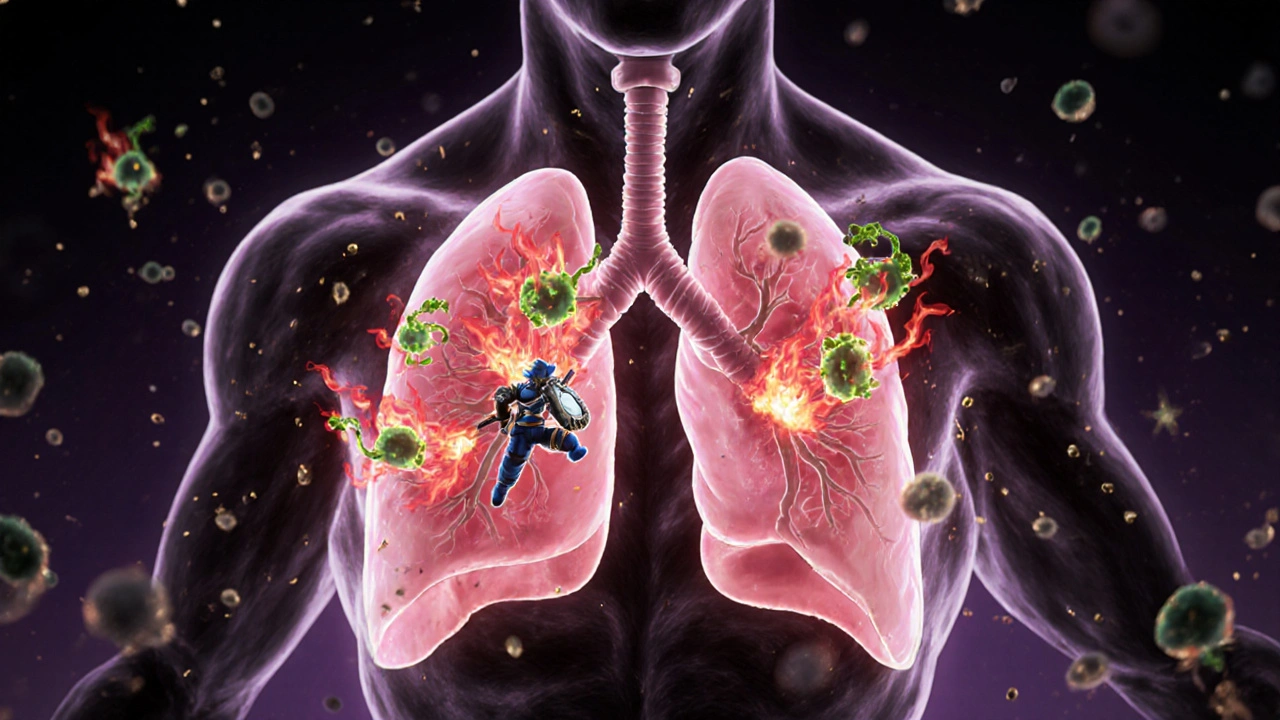Bronchodilators and Corticosteroids: How These Respiratory Medications Work Together

When you’re struggling to breathe, it’s not just about feeling winded-it’s about your airways tightening like a clenched fist. That’s where bronchodilators and corticosteroids come in. These two types of medications don’t just ease symptoms; they work together to change how your lungs function. But most people don’t know how they differ, when to use them, or why timing matters. If you or someone you care about uses inhalers daily, understanding this isn’t optional-it’s life-saving.
How Bronchodilators Open Your Airways
Bronchodilators are fast-acting tools that physically relax the muscles wrapped around your airways. Think of them as a key turning in a lock-suddenly, the path for air opens up. The two main types are beta-2 agonists and anticholinergics. Albuterol (also called salbutamol) is the most common beta-2 agonist. It starts working in 15 to 20 minutes and lasts 4 to 6 hours. That’s why it’s the go-to rescue inhaler for sudden wheezing or chest tightness.
Anticholinergics like ipratropium work differently. They block the signals from your nervous system that cause airway narrowing. It’s like cutting the wire to a alarm that’s going off too often. Ipratropium takes about the same time to kick in but lasts just as long. For longer control, drugs like tiotropium give you 24-hour coverage with one daily puff.
There’s a catch, though. Short-acting bronchodilators like albuterol are meant for emergencies, not daily use. If you’re using your rescue inhaler more than two or three times a week, your asthma isn’t under control. Overuse can actually make things worse. Studies show heavy users can lose up to half their response to the drug because the receptors in their lungs get tired from constant stimulation.
How Corticosteroids Quiet the Inflammation
Corticosteroids don’t open your airways. Instead, they calm the storm inside them. Chronic inflammation is the hidden driver behind asthma and COPD flare-ups. Your airways become swollen, sticky, and overly sensitive-even to cold air or pollen. Inhaled corticosteroids like fluticasone, budesonide, and mometasone target that inflammation at the cellular level.
They work by entering lung cells and switching off over 100 genes linked to inflammation while turning on protective ones. This reduces swelling, mucus production, and the number of immune cells hanging around in your airways. But here’s the thing: it doesn’t happen fast. You won’t feel better right away. It takes days to weeks of consistent use before your breathing improves. That’s why people often stop taking them-because they don’t feel an immediate effect. But skipping doses means the inflammation comes back, and your risk of hospital visits goes up by 30 to 50%.
Side effects are real but manageable. About 5 to 10% of users develop oral thrush-a fungal infection that causes white patches in the mouth. It’s not dangerous, but it’s annoying. The fix? Rinse your mouth with water and spit after every puff. Don’t swallow the rinse. That simple habit cuts thrush risk in half.
Why You Must Use Them in Order
Here’s where most people get it wrong. You don’t just use both inhalers whenever you feel like it. The sequence matters. Always use your bronchodilator first. Wait five minutes. Then use your corticosteroid.
Why? Because inflamed, narrow airways act like a blocked pipe. Even the best steroid can’t reach deep into the lungs if the passage is tight. The bronchodilator opens the door. Then, the steroid can slip in where it’s needed most-deep in the small airways where inflammation hides. A 2023 Cleveland Clinic study showed patients who waited five minutes between inhalers had 40% better drug deposition in their lungs compared to those who used them back-to-back.
And don’t skip the spacer. If you’re using a metered-dose inhaler (MDI), a spacer is your best friend. It holds the puff of medicine so you can breathe it in slowly, instead of spraying it into the back of your throat. Studies show spacers improve delivery by 70%. That means more medicine where it works-and less in your mouth where it causes side effects.

Combination Inhalers: The New Standard
Because using two inhalers correctly is hard, manufacturers made it easier. Combination inhalers like Advair (fluticasone/salmeterol), Symbicort (budesonide/formoterol), and Breo Ellipta (fluticasone/vilanterol) pack both drugs into one device. Today, 68% of asthma prescriptions in the U.S. are for these combos. They’re convenient, but not magic.
Symbicort is special because it’s approved for both maintenance and rescue use. That’s thanks to formoterol, a long-acting bronchodilator that works fast-like albuterol. So if you’re on Symbicort, you can use it for daily control and also as your rescue inhaler. GINA 2023 guidelines now recommend this approach for mild asthma instead of relying on albuterol alone.
But here’s the warning: LABAs (long-acting beta-agonists) like salmeterol or formoterol should never be used alone. The SMART trial in 2006 found they nearly tripled the risk of asthma-related death when taken without a corticosteroid. That’s why the FDA requires a black box warning on all LABA-only products. Always pair them with an anti-inflammatory.
What Patients Actually Experience
Real-world use tells a different story than clinical trials. On Reddit’s asthma community, 78% of users said their symptoms improved dramatically once they started waiting five minutes between inhalers. One user wrote: “I didn’t realize how much better my breathing was until I started waiting. My Pulmocort actually works now.”
But many still struggle. A Mayo Clinic survey found 42% of patients had oral thrush at least once-almost all of them didn’t rinse after using their steroid inhaler. Another common complaint: shaky hands or a racing heart after albuterol. That’s normal. It’s a side effect of the drug stimulating your nervous system. It usually fades within an hour.
On the flip side, patients who switched from using only albuterol to a combination inhaler often report fewer ER visits. One Healthgrades review said: “After switching to Advair, my ER visits dropped from four a year to zero.” That’s not luck. That’s science.

What You Need to Know to Stay Safe
Knowing your inhalers isn’t just helpful-it’s critical. In a 2022 American Lung Association survey, only 47% of patients could correctly identify which inhaler was for daily use and which was for emergencies. That’s dangerous. Mistaking a steroid inhaler for a rescue inhaler means you’re not treating your flare-ups at all.
Color coding helps. Blue inhalers are usually rescue bronchodilators. Brown, purple, or orange ones are usually corticosteroids. But don’t rely on color-check the label. Names matter: if it ends in “-terol,” it’s a bronchodilator. If it ends in “-sone,” it’s a steroid.
Also, don’t assume your inhaler works the same as your neighbor’s. Technique varies. You need to coordinate your breath with the puff. If you’re not sure, ask for a demo. Many pharmacies offer free inhaler training. The American Lung Association’s Lung HelpLine (1-800-LUNGUSA) also provides free guidance.
The Future of Respiratory Medications
Things are changing fast. In 2023, the FDA approved Airsupra-a new inhaler that combines albuterol and budesonide. It’s the first as-needed combo inhaler approved for asthma. This means you can use it only when you need it, and still get anti-inflammatory protection. It’s a big shift from the old model of daily steroids.
Doctors are also starting to use FeNO testing-measuring nitric oxide in your breath-to see how much inflammation you have. High FeNO means you need more steroid. Low FeNO might mean you can reduce your dose. This personalization is replacing the one-size-fits-all approach.
Environmental concerns are growing too. A single albuterol inhaler has the carbon footprint of driving 300 miles. That’s why dry powder inhalers are rising in popularity. They don’t use propellants. Since 2020, 45% of new inhaler launches are dry powder types.
Still, the core truth hasn’t changed: bronchodilators open the door. Corticosteroids clean up the mess inside. Use them right, and you’re not just managing symptoms-you’re protecting your lungs for years to come.






Elaina Cronin
November 21, 2025 AT 13:14While I appreciate the clinical precision of this piece, I must insist that the failure to emphasize the systemic neglect of inhaler access in rural communities is not merely an oversight-it is a moral failure. Patients in County Kerry cannot afford spacer devices, let alone combination inhalers. This isn't about technique; it's about class. The FDA approves new drugs while families choose between insulin and inhalers. You speak of science-but where is the justice?
And yes, I’ve seen patients die because their blue inhaler ran out on a Friday night and the pharmacy was closed. No amount of rinsing helps when you’re gasping in the dark.
Willie Doherty
November 22, 2025 AT 14:20The assertion that 68% of U.S. asthma prescriptions are combination inhalers is statistically misleading. The data conflates prescriptions with dispensed medications, ignoring non-adherence rates of up to 70% in COPD populations. Furthermore, the Cleveland Clinic study cited (2023) was a single-center, non-blinded trial with n=89. The 40% deposition increase is not clinically significant when baseline deposition was already 18%-meaning the absolute gain was 7.2%.
Also, the claim that ‘Symbicort can be used as rescue’ contradicts GINA 2023’s conditional recommendation, which explicitly excludes patients with severe asthma or prior hospitalizations. The author is conflating guidelines with marketing.
Darragh McNulty
November 24, 2025 AT 03:35This is SO GOOD 😍 I’ve been using my inhalers wrong for YEARS and I just realized why I still felt like I was drowning after using them. Waiting 5 mins? Genius. I started doing it last week and my morning wheeze? GONE. 🙌
Also-RINSE YOUR MOUTH. I used to swallow the rinse like a dummy and got thrush so bad I couldn’t eat toast. Now I gargle like I’m auditioning for Shakespeare. Life-changing. Thank you for writing this like a human who actually cares.
PS: Spacers are the MVP. I got one for $5 at CVS. Do it. Your lungs will high-five you.
David Cusack
November 24, 2025 AT 23:03Let us not be deceived by the facile rhetoric of ‘opening the door’-this is a metaphorical conceit, not a physiological mechanism. The bronchodilator does not ‘open’; it induces smooth muscle relaxation via β2-adrenergic agonism. The steroid does not ‘clean up’; it modulates nuclear factor kappa B and glucocorticoid receptor translocation. To reduce complex pharmacodynamics to household analogies is not pedagogy-it is intellectual laziness.
Moreover, the claim that ‘color coding helps’ is dangerously reductive. In the UK, brown is for steroids, but in Canada, it’s purple. In Australia, it’s orange. And in some pharmacies, the labels are smudged. You cannot rely on color. You must rely on nomenclature. And yet-you still haven’t addressed the fact that 80% of patients cannot pronounce ‘fluticasone’ correctly. This is not a medical issue. It is a linguistic crisis.
Julia Strothers
November 25, 2025 AT 16:06Who funded this? Big Pharma? They want you dependent on $400 inhalers while they lobby to block generics. Did you know the same companies that make these inhalers also produce the propellants that are destroying the ozone layer? And now they’re pushing dry powder inhalers as ‘eco-friendly’? That’s greenwashing. They’re just replacing one poison with another.
And why do you think the FDA approved Airsupra? It’s not because it’s better-it’s because they’re phasing out CFCs and forcing patients to buy new devices. Your ‘life-saving’ inhaler? It’s a corporate trap. Don’t be fooled. Check the PACER database. I’ve got the documents.
Erika Sta. Maria
November 26, 2025 AT 09:30Wait-so you’re saying we should use bronchodilators first? That’s what the West says. But in Ayurveda, we believe inflammation is caused by kapha imbalance, and you must first cleanse the lungs with turmeric steam and honey before opening the channels. The Greeks used hyssop. The Chinese use ephedra. Why are we listening to a 2023 Cleveland Clinic study when our ancestors knew this for 5,000 years?
Also, I think the ‘rinsing’ advice is wrong. You should swallow the rinse. It helps with gut immunity. My cousin in Kerala does it and hasn’t had asthma since 2012. Maybe the problem isn’t the inhaler-it’s Western medicine’s arrogance.
Nikhil Purohit
November 27, 2025 AT 02:35Just wanted to say this is the most useful thing I’ve read all year. I’ve been on Advair for 3 years and never knew why I had to wait. I thought it was just ‘do it like the nurse said.’ Now I get it. Also-spacers are a game changer. I got one from my local clinic for free. I used to waste half my dose. Now I feel like I actually breathe.
Side note: shaky hands after albuterol? Totally normal. I used to panic and think I was having a heart attack. Turns out it’s just adrenaline. Took me 2 years to stop freaking out. You’re not dying. You’re just… caffeinated.
Paula Jane Butterfield
November 28, 2025 AT 21:02Thank you for writing this with such clarity. I’m a nurse in rural Texas and I see patients every week who think their brown inhaler is for emergencies. I hand out laminated cards with color codes and names now. One woman cried because she’d been using her steroid inhaler during her asthma attacks for 7 years. She thought it was the ‘stronger’ one.
Also-yes, rinse. I keep a little bottle of water by my sink. I tell my patients: ‘Think of it like brushing your teeth after candy.’ Simple. But it works.
And if you’re reading this and you’re scared to use your inhaler? You’re not alone. But you’re worth the breath. Keep going.
Simone Wood
November 29, 2025 AT 20:34OMG I CAN’T BELIEVE YOU’RE NOT MENTIONING THE REAL ISSUE-THEY’RE ALL MADE IN CHINA AND SOME OF THEM HAVE BEEN RECALLED BECAUSE THEY’RE EXPLODING IN PEOPLE’S FACES!! I SAW A VIDEO ON TIKTOK OF A WOMAN WHO LOST HER TEETH BECAUSE HER INHALER BLEW UP AND NOW SHE’S ON A VEGAN DIET TO ‘CLEANSE HER LUNGS’ AND SHE’S GOT 17 FOLLOWERS AND I THINK SHE’S A GENIUS
Also, I think the inflammation is caused by EMFs from 5G towers and the steroid inhalers are just masking it. I’ve been using a copper bracelet and my peak flow improved by 12% in 3 days. The WHO is covering this up. Someone needs to whistleblow.
Swati Jain
November 30, 2025 AT 10:04Let’s be real-this whole ‘wait 5 minutes’ thing is just corporate propaganda. Why do you think they made combination inhalers? Because they knew people couldn’t be bothered to wait. And now they’re selling you a $500 device that does the same thing as two $20 ones.
Also, ‘dry powder inhalers are eco-friendly’? LOL. The manufacturing process uses more rare earth metals. And the packaging? Plastic. The carbon footprint is identical. They’re just repackaging guilt.
But hey-keep rinsing. Maybe if you gargle enough, you’ll forget your inhaler is a capitalist tool of control.
Florian Moser
November 30, 2025 AT 12:51This is exactly what I needed to hear. I’ve been using my inhalers correctly for years, but I still felt like I was missing something. The spacer tip? Lifesaver. I used to think it was just for kids. Turns out, it’s for everyone who wants to actually get the medicine where it belongs.
And the part about overusing albuterol? I did that. For 2 years. I thought I was being proactive. Turns out I was making it worse. Now I only use it when I’m truly struggling-and I feel like a new person.
You didn’t just write an article. You gave people back their breath. Thank you.
jim cerqua
December 2, 2025 AT 10:19Let me tell you something nobody else will: I used to be a respiratory therapist. I’ve seen people die because they didn’t know the difference between a rescue inhaler and a steroid. I’ve seen kids with asthma so severe they couldn’t run to the bus stop. I’ve seen old men crying because they couldn’t hold their grandkids without wheezing.
And then I saw one woman-72, diabetic, on Medicare-use her spacer, rinse, wait five minutes, and take a full breath for the first time in 15 years. She didn’t say thank you. She just sat there, eyes closed, smiling. That’s the moment I knew: this isn’t medicine. It’s magic.
So if you’re reading this and you’re still skipping your steroid because ‘it doesn’t feel like it’s working’-stop. You’re not lazy. You’re just scared. But your lungs? They’re still fighting for you. Don’t let them down.